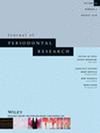Periodontal tissue regeneration with cementogenesis after application of brain-derived neurotrophic factor in 3-wall inflamed intra-bony defect
Abstract
Objective
The purpose of this study is to investigate regenerative process by immunohistochemical analysis and evaluate periodontal tissue regeneration following a topical application of BDNF to inflamed 3-wall intra-bony defects.
Background
Brain-derived neurotrophic factor (BDNF) plays a role in the survival and differentiation of central and peripheral neurons. BDNF can regulate the functions of non-neural cells, osteoblasts, periodontal ligament cells, endothelial cells, as well as neural cells. Our previous study showed that a topical application of BDNF enhances periodontal tissue regeneration in experimental periodontal defects of dog and that BDNF stimulates the expression of bone (cementum)-related proteins and proliferation of human periodontal ligament cells.
Methods
Six weeks after extraction of mandibular first and third premolars, 3-wall intra-bony defects were created in mandibular second and fourth premolars of beagle dogs. Impression material was placed in all of the artificial defects to induce inflammation. Two weeks after the first operation, BDNF (25 and 50 μg/mL) immersed into atelocollagen sponge was applied to the defects. As a control, only atelocollagen sponge immersed in saline was applied. Two and four weeks after the BDNF application, morphometric analysis was performed. Localizations of osteopontin (OPN) and proliferating cell nuclear antigen (PCNA)-positive cells were evaluated by immunohistochemical analysis.
Results
Two weeks after application of BDNF, periodontal tissue was partially regenerated. Immunohistochemical analyses revealed that cells on the denuded root surface were positive with OPN and PCNA. PCNA-positive cells were also detected in the soft connective tissue of regenerating periodontal tissue. Four weeks after application of BDNF, the periodontal defects were regenerated with cementum, periodontal ligament, and alveolar bone. Along the root surface, abundant OPN-positive cells were observed. Morphometric analyses revealed that percentage of new cementum length and percentage of new bone area of experimental groups were higher than control group and dose-dependently increased.
Conclusion
These findings suggest that BDNF could induce cementum regeneration in early regenerative phase by stimulating proliferation of periodontal ligament cells and differentiation into periodontal tissue cells, resulting in enhancement of periodontal tissue regeneration in inflamed 3-wall intra-bony defects.

 求助内容:
求助内容: 应助结果提醒方式:
应助结果提醒方式:


